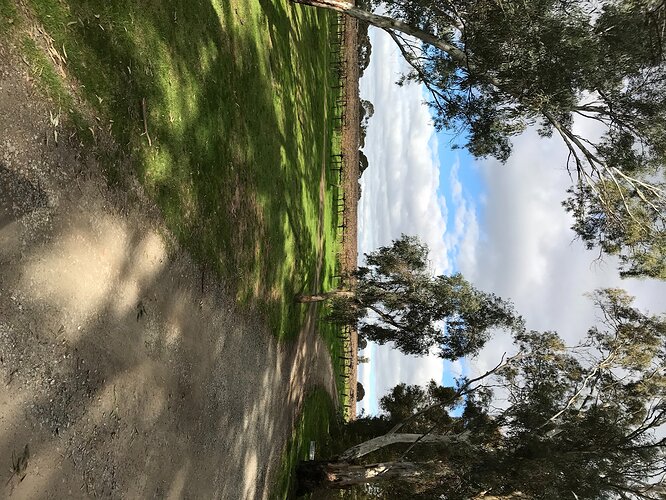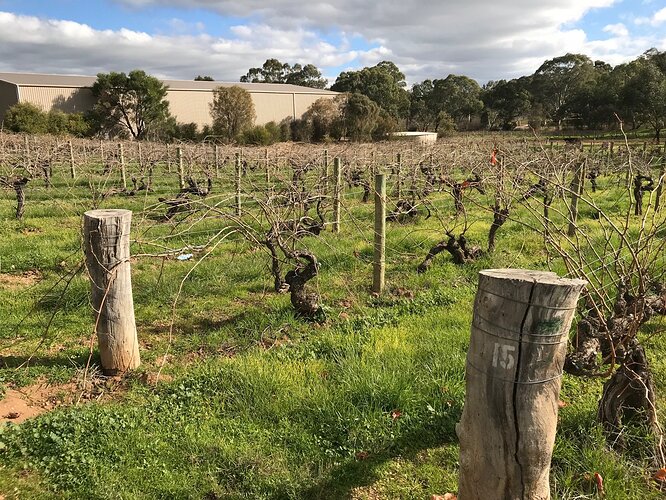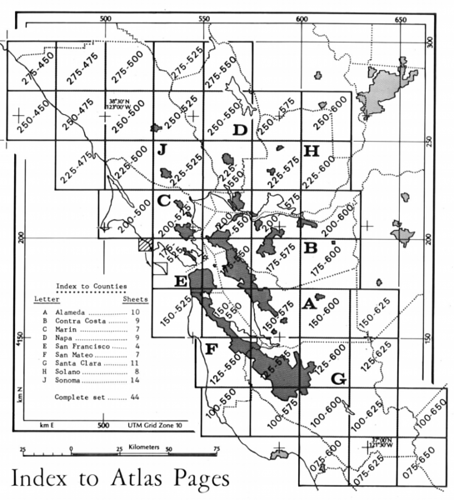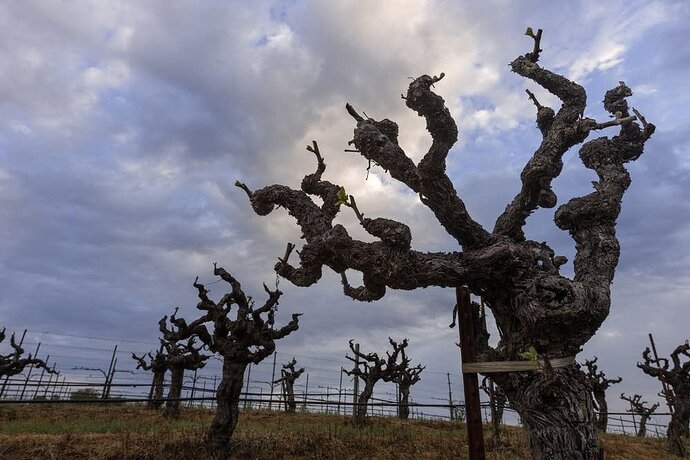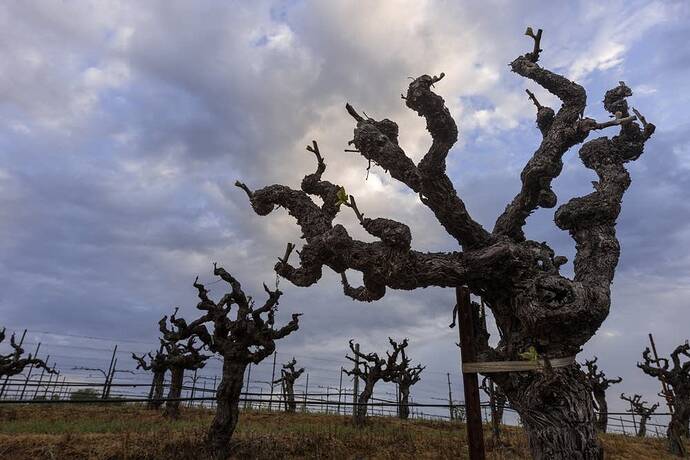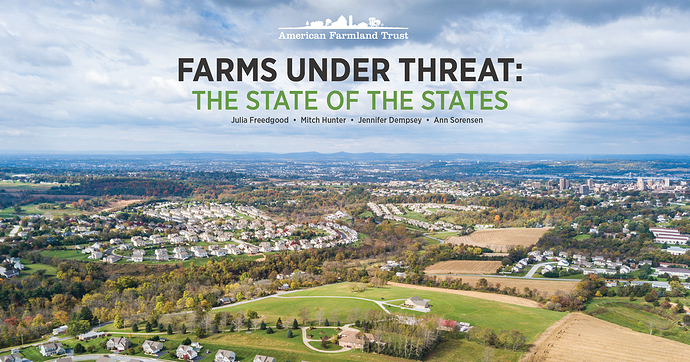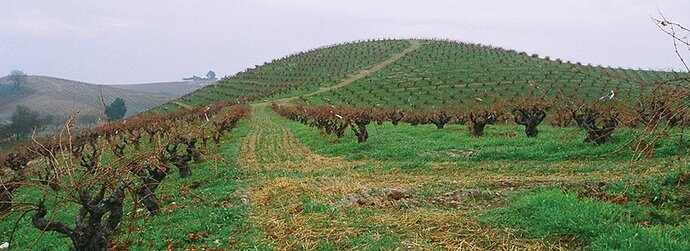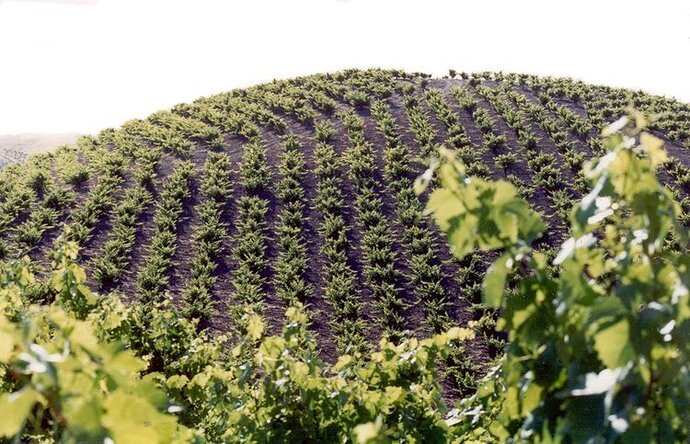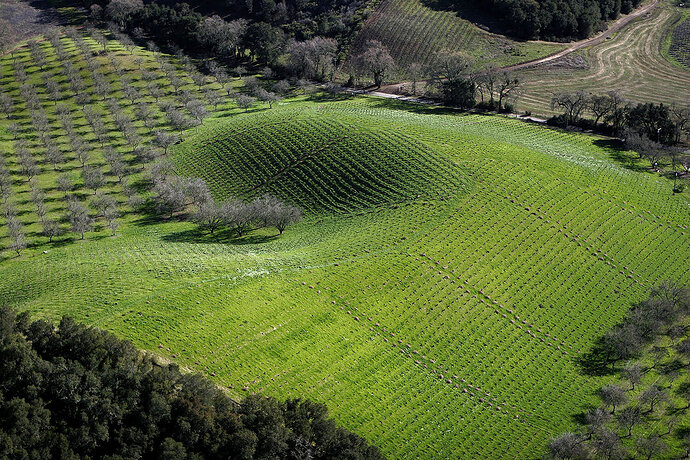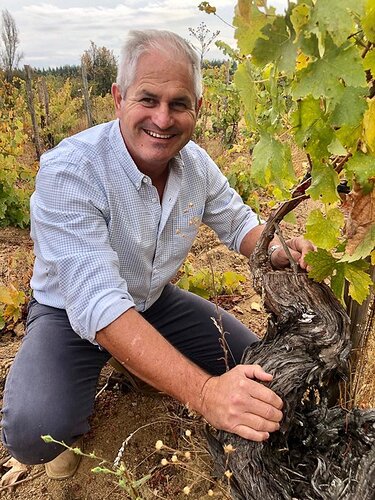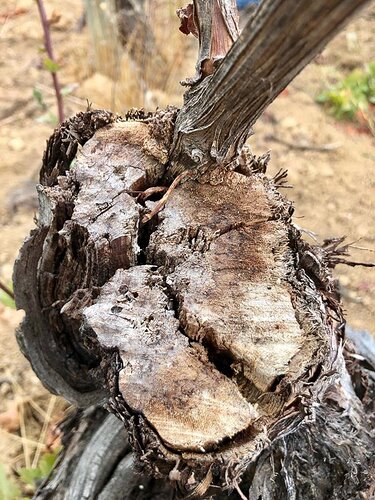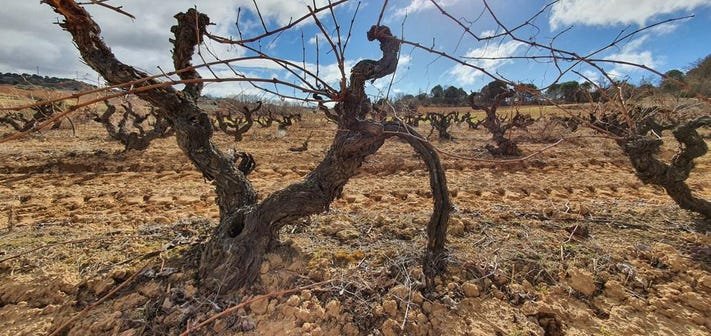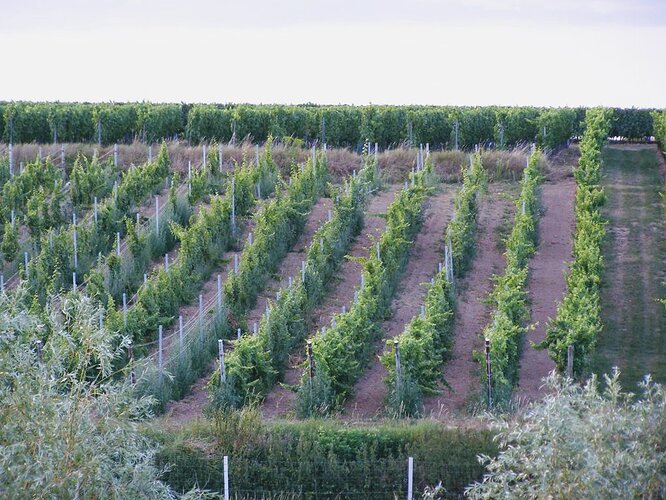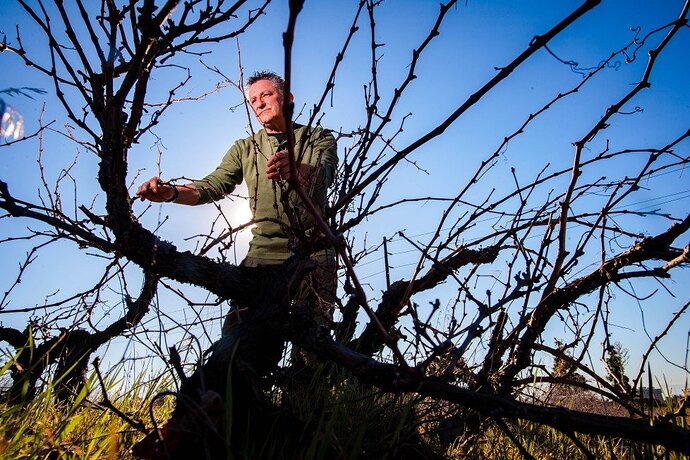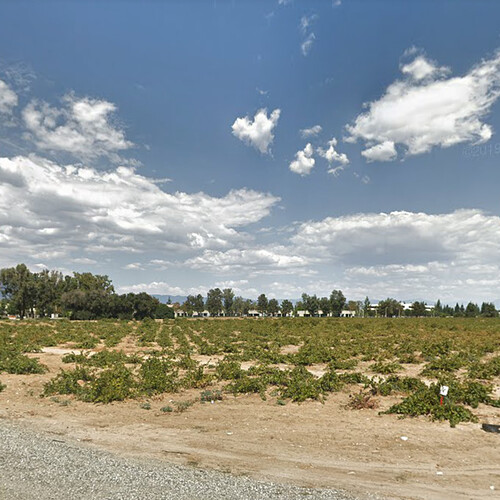When an ancient vineyard is slated for destruction, cuttings taken from grapevines can be relocated and transplanted.
There is a certain novelty in cultivating heirloom vine cuttings in one’s backyard. Might not samples also be gathered and studied by plant scientists? It would be negligent to destroy a potentially irreplaceable viticultural resource.
Certain old-growth vines might possess rare/desirable traits if more closely studied. Greater efforts ought to be devoted to collect, assess, and catalogue cuttings from grapevines growing under the shadow of the bulldozer.
Daily Bulletin
“Take Home a Vintage Grapevine from Old Rancho Cucamonga Vineyard”
by David Allen
February 11, 2020
"…Grapevines from a dormant vineyard in Rancho Cucamonga will be offered for sale at $25 each. It’s a chance to take a home some living history to decorate your yard, if not produce your own wine.
“‘We’ve had a lot of interest. Some people have already been out here marking vines they wish to adopt,’ said George Walker, a wine enthusiast and historian who encourages home winemaking.
"The [‘Gateway Vineyard’] site is the northeast corner of N Haven Avenue and Fourth Street [in Ontario, CA]. It was a high-profile grape-picking spot each fall, an opportunity to see an age-old valley tradition unfold amid development as you cruised by on the busy thoroughfares.
"The property’s Zinfandel and Rose of Peru vines are believed to date to the 1930s. Walker said they may be the only old-time vines left within city limits.
"Grapes were last harvested there in 2017 by Galleano Winery, which had leased the land. Warehouses have gone up on the east side. Hotels are proposed for the remainder, but that project may not get started in 2020.
"…Walker said the city’s planning director introduced him to the would-be developer, who gave him the green light to dispose of as many vines as he can. He guesses there are 2,000 vines and doesn’t expect them all to sell.
"…Once replanted, a vine will begin growing a new tap root. After the first couple of years, watering isn’t required because the root will find water underground.
"I phoned Don Galleano, owner of Galleano Winery, for his take. He said it’s not good for the vines that they haven’t been pruned in two years.
“‘But he picked a great time to do this because they should be dormant,’ Galleano said. ‘I wish everyone good luck. It’s an ambitious endeavor.’"
“George Walker, president of Cucamonga Home Wine Society, shows an old grapevine at a former vineyard on Fourth and Haven in Rancho Cucamonga on Thursday, Feb. 6, 2020. Old vines from the former vineyard will be offered for sale Feb. 8, 15 and 22 by the Cucamonga Home Wine Society.”
"On the site Thursday morning, Walker showed me new branches forming on some of the vines. Even if they won’t be as fruitful since they haven’t been pruned for a while, the new buds show the vines still have some life in them. By transplanting them while they’re dormant, he said, the vines will ‘wake up’ in new soil.
"There may be a second opportunity to reclaim the vines this fall after the harvest season when they will go dormant again.
"The retired probation officer and home vintner has made a side business out of saving vines.
“‘When an old vineyard is going to be developed, we’d like to go in there and rescue the vines. Because they can be rescued,’ [George] Walker told me. ‘I’ve done about 6,000.’
“The success rate from transplanting them is ‘around 80%,’ Walker said. ‘Some will “take” and last five years. Some are still going strong that we transplanted 10 years ago.’”
Cuttings from the “De Ambrosio Vyd” were planted at CalPoly Pomona’s “Horsehill Vineyards” agricultural facility. Students produce wines annually from these heirloom grapevines.
Cal Polytech Pomona
“The Prized-Lineage of Horsehill Vineyards”
"In 2001, Don Galleano combed the fields in Rancho Cucamonga and selected 400 grapevine cuttings, some of them nearly 100 years old, from the ‘De Ambrogio Ranch’ vineyard just before it was razed for development. The third-generation vintner operates the Galleano Winery in Mira Loma and Galleano Enterprises, the largest shipper of grapes in Southern California.
“‘We wanted to take these prized cuttings from the “De Ambrogio Ranch”, which represents a lot of the history of the Cucamonga Valley, and preserve them for future generations,’ says Galleano.
“…The cuttings from ‘De Ambrogio Ranch’ were potted in Cal Poly Pomona’s nursery with the hope of maintaining a small piece of the Cucamonga Valley’s rich wine-producing history. Today, the old-line Zinfandel vines, which have won multiple gold medals in international wine competitions, are part of the university’s viniculture program preparing students for careers in one of California’s leading industries…”.
Additional Resources - Cucamonga Valley:
• “Gateway Vineyard”:
Daily Bulletin
“One Last Grape Harvest in Rancho Cucamonga Vineyard”
by David Allen
August 31, 2017
"Traffic sped past on Haven Avenue and Fourth Street, but in the middle of the [‘Gateway Vineyard’], the bustle was in the rhythm of the labor.
"Field workers efficiently grabbed clusters of grapes off the vines. Gloved hands tossed the grapes into plastic trays. When the trays were full, they were hoisted to the shoulder, or to the top of the head, and walked to a waiting truck. The tray was emptied, a token handed over and it was back to picking.
"It’s an age-old process in which technology plays little part, at least in the field.
"‘Every vine is pruned. It’s a full hand-harvest of the fruit,’ said Don Galleano, the third-generation winemaker whose Galleano Winery would turn the grapes into wine.
"The vineyard itself is likely to be uprooted, however. The property is slated for development.
"…Said Galleano, who had leased the land since the 1980s: ‘I reckon this is the last harvest.’
"He had dubbed it ‘Gateway Vineyard’ because the land is a gateway to Rancho Cucamonga. The annual harvest, which lasts only a few days, has the whiff of bygone days: workers in big straw hats stooped over their labors, yanking grapes from vines in the field, even as development occurs all around.
"…I learned about the final harvest when I ran into Gino Filippi, the wine writer and Upland councilman, on Tuesday.
“‘That’s been a vineyard for 85, 90 years. It’s sad,’ Filippi said.
"Galleano said that estimate sounded right to him. He expects the vineyard was planted after the end of Prohibition in 1933. Zinfandel grapes have always been grown there. For decades, Frank DeAmbrogio would ship the grapes to home winemakers across the United States. Galleano took over the land from him in the 1980s and supplied a winery in Northern California [Geyser Peak] before using the grapes at his own winery in recent years.
“The vineyard is 26 acres. Galleano said an acre would have 430 vines, which would mean the site has more than 10,000. They will produce about 25 tons of grapes…”.
• “DeAmbriogio Ranch” (Uprooted) :
Gino Off the Vine Blog
“Upland Winegrowers Alive”
by Gino L. Filippi
November 25, 2011
"…For the past decade, Denson’s interest in growing vines and producing wines has transformed from general interest to deep passion. He first became interested in the viticulture history of Rancho Cucamonga upon his daily commutes past the old Thomas Brothers Winery site. ‘I began to wonder, this is a great old winery building, but where did all the vines go? With the housing boom, I noticed more and more vineyards being replaced by new homes and retail centers. It made me sad to see such a rich part of the cultural history of Rancho vanish before my eyes,’ said Denson, who serves as Director of Design at Architerra Design Group in Rancho Cucamonga.
"…Denson inquired about growing and producing with his fellow co-worker, John Federico, who had worked the ‘DeAmbrogio Ranch’ many years before as a young man. ‘He knew a great deal of history about the vineyard, and right before the property was graded over, we drove through the vineyard rows in winter and picked up some of the recently pruned canes. It’s my understanding that some of the vines on that property were over 100 years old. I thought it would be a good legacy to preserve the parent plants of this vineyard.’
"Denson began his vineyard with a dozen vine cuttings, selected from various varieties at the historic ‘DeAmbriogio Ranch’. 'Maybe half rooted in from the original planting and, after a couple of years of growth, I took additional cuttings and increased the number of vines. Currently, I have about 30 Zinfandel vines, 4 Red Malaga, 2 Syrah, 2 Thompson Seedless and 1 Mission on our standard residential 8,000 square foot lot in Upland,’ said Denson.
"…Originally located on the southwest corner of Foothill Blvd (Route 66) at Haven Avenue (west of the Rancho Cucamonga Civic Center), the famed ‘DeAmbrogio Ranch’ served as the valley’s grape packing and shipping center. ‘Mary and Frank DeAmbrogio were the last of the large grape packers and shippers of our valley,’ said local winemaker Don Galleano. 'I remember they were sending their prized Cucamonga Zinfandel grapes to the east coast as late as the early 1980’s via refrigerated trucks.
"…[Denson said,] 'What originally started off as a idea to preserve a portion of viticulture history of the Cucamonga Valley has blossomed into a family tradition that marks the culmination of another growing season. Each year I bottle up a little gift of Denson Reserva Cucamonga Valley Zinfandel for those who attend our family harvest!’
“Local wine enthusiasts may also appreciate the small vineyard planting located at the Mercury Insurance building in Rancho Cucamonga, designed by Architerra Design Group in Rancho Cucamonga.”
LA Times
“Uprooting Old Vines”
by Jerry Hirsch
October 11, 2003
"…This is California’s original wine country - and it’s going fast. Decades before Napa Valley became synonymous with California wine, Cucamonga Valley, about an hour east of Los Angeles, was home to more than 35,000 acres of vineyards and as many as 60 wineries.
"Today, the Cucamonga Valley American Viticulture Area is down to fewer than 800 acres of vineyard and three commercial wineries, including Galleano’s, whose namesake business produces about 100,000 gallons of mostly bulk wine annually.
"Nestled in one of the fastest-growing regions in the state, Cucamonga Valley has become far too valuable for growing grapes: An undeveloped acre can fetch upwards of $200,000. Yet the surviving 50-to-100-year-old vines scattered across the valley’s floor are prized within the wine industry for their complex fruit. ‘The great irony here is that Cucamonga Zinfandel now has a higher reputation than it did when this was a vast growing region,’ said Thomas Pinney, a retired Pomona College professor and author of [u]A History of Wine in America: From the Beginnings to Prohibition[/u].
“…‘These were very old vines … and may have been some of the original cuttings from the Old World,’ Chattan said.
"Despite its rich heritage, the 35-acre ‘De Ambrogio Ranch’ was not a very profitable business, yielding only $10,000 to $20,000 a year in income for the family that had owned the property for three generations. With the clan’s 86-year-old matriarch in an assisted-living facility, the De Ambrogio family decided to sell the land two years ago.
“…‘We all knew that ‘De Ambrogio’ was going to disappear, if for no other reason than it was at the intersection of two busy streets,’ Chattan said.
"All that’s left of the historic ‘De Ambrogio Vineyard’ are about two acres of Zinfandel cuttings planted at Cal Poly Pomona, as well as several vines that have been transplanted in Napa Valley, where UC Davis researchers hope to preserve the old-growth strain.
“‘If this was a structure, they would have declared it a historical site and prevented this from happening,’ said James Wolpert, chairman of the UC Davis Department of Viticulture and Enology. ‘You just don’t make 100-year-old Zinfandel vines. We are losing a piece of California’s heritage’…".
• “Lopez Vineyard”:
Fontana Herald News
“Galleano Winery Pickers are Harvesting 220 Acres of Wine-Producing Vines on Lopez Ranch in Fontana”
by Mike Myers
September 13, 2019
Wine Spectator
“Disappearing Act: A Once-Vast Southern California Wine Region Faces an Uncertain Future”
by Jean T. Barrett
January 18, 2001
![]()
